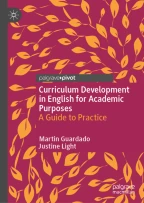Evaluating the Plan and Lived Experience of the Curriculum: Completing the Circle

Evaluating the Plan and Lived Experience of the Curriculum considers the final stage in the curriculum development process, evaluation. In fact, this chapter describes the ongoing cyclical nature of curriculum evaluation, rather than viewing it as one, final stage in a linear process. The authors consider the practical aspects of curriculum evaluation, the why, when, how, and who of the process. Practical tools for the process are included, in particular, potential goals for the evaluation and questions to ask, and what data to gather to achieve these goals are discussed. As in every chapter, Guardado and Light provide a candid summary of how they engaged with this evaluation process in their EAP context. Finally, some resources to support curriculum planning are included.
This is a preview of subscription content, log in via an institution to check access.
Access this chapter
Subscribe and save
Springer+ Basic
€32.70 /Month
- Get 10 units per month
- Download Article/Chapter or eBook
- 1 Unit = 1 Article or 1 Chapter
- Cancel anytime
Buy Now
Price includes VAT (France)
eBook EUR 50.28 Price includes VAT (France)
Hardcover Book EUR 63.29 Price includes VAT (France)
Tax calculation will be finalised at checkout
Purchases are for personal use only
References
- Aoki, T. T. (1993). Legitimating lived curriculum: Towards a curricular landscape of multiplicity. Journal of Curriculum and Supervision,8(3), 255–268. Google Scholar
- ATESL. (2009). Best practices for adult ESL and LINC programming in Alberta. ATESL. Google Scholar
- Beile, P. (2008). Information literacy assessment: A review of objective and interpretive measures. In K. McFerrin, R. Weber, R. Carlsen & D. Willis (Eds.), Proceedings of SITE 2008—Society for Information Technology & Teacher Education International Conference (pp. 1860–1867). Las Vegas, NV: Association for the Advancement of Computing in Education (AACE). Retrieved from https://www.learntechlib.org/primary/p/27469/.
- Chambers, W., Gnida, S., Messaros, C., Ilott, W., & Dawson, K. (2011). ATESL adult ESL curriculum framework. ATESL, Canada. Google Scholar
- Diamond, R. M. (2008). Designing and assessing courses and curricula: A practical guide. San Francisco, CA: Jossey Bass. Google Scholar
- Guardado, M., & Light, J. (2018). Innovation in EAP programmes: Shifting from teaching to learning in curriculum design. In L. T. Wong & W. L. Wong (Eds.), Teaching and learning English for academic purposes: Current research and practices (pp. 143–160). Hauppauge, NY: Nova Science Publishers. Google Scholar
- Hyland, K., & Tse, P. (2007). Is there an “academic vocabulary”? TESOL Quarterly,41, 235–253. https://doi.org/10.1002/j.1545-7249.2007.tb00058.x. ArticleGoogle Scholar
- Languages Canada. (2018). Quality assurance scheme standards and specifications. Retrieved from https://www.dropbox.com/sh/73vvpeafcwcqo53/AAAxh7gT_CwF0mXSwiQrnLE8a?dl=0&preview=LCS01_STANDARDS_SPECIFICATIONS_February_2018+highlighted+changes.pdf.
- Nation, I. S. P., & Macalister, J. (2010). Language curriculum design. New York, NY: Routledge. Google Scholar
- Sauvé, V. (2009). A curriculum frameworks research project. Unpublished report for Alberta Employment and Immigration. Google Scholar
Author information
Authors and Affiliations
- University of Alberta, Edmonton, AB, Canada Martin Guardado
- NorQuest College, Edmonton, AB, Canada Justine Light
- Martin Guardado

